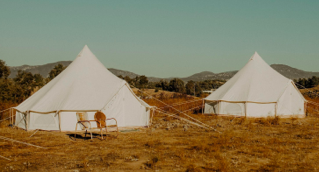Menu
-
- Shop
- Glamping Tents
- Wall Tents
- Canvas Tent
- Bell Tents
- Festival Tents
- Hunting Tents
- Yurt Tents
- Family Tents
- Stargazing Tent
- Cabin Tents
- Camping Gifts
- Overland Tents
- Tent Stoves
- 4 Person Tents
- 6 Person Tents
- 8 Person Tents
- 12 Person Tents
- Canvas Bags
- Camp Gears
- Camping Chairs
- Shade Canopy Tents
- Camping Fans
- Resources
- About
- Contact Us
- Reviews
-
- Login

Free Shipping

Pay No Sales Tax
30-Month Warranty
Tents
Shop


The LiT List
Glamping & Camping Ideas + Resources
How to Keep Your Tent Clean and Dry on a Camping Trip (Inside and Out)
4 min read
Did an unexpected deluge rain on your camping or glamping parade? Even when conditions stay dry, moisture can accumulate in your camping tent, damaging it over time. Worse, it fosters mold and mildew growth, which can impact your health.
What can you do to stay safe, toasty and dry, above all? Here’s how to keep your tent clean and dry inside and out on your next camping trip.

How to Keep Your Tent Dry in the Rain: 6 Tips
Even the experts don’t always get the weather prediction right. Here’s how to keep your tent dry in the rain for an enjoyable trip.
1. Find the Right Site
Finding the right site involves wise decision-making. Your instinct might say, “Set up under a tree,” but doing so is problematic for two reasons:
- Widowmakers:Although unlikely, lightning or high winds could bring a heavy branch — or the entire tree — down on you during the night.
- Drip, drip, drip:Although foliage offers limited rain protection, the leaves drip for hours after showers stop. You open the zipper to greet the morning sun and get an unexpected shower.
Use caution with similar shelters. For example, a rock overhang offers appealing shelter, but you should ensure it’s sturdy.
Determine which direction the wind is blowing from and orient your tent opening in the opposite direction to keep rain from blowing into your tent every time you enter. Also, stay away from bodies of water, which can flood.
2. Pitch Your Tent Properly
Practice setting up your tent in an easy location to master the ropes so you aren’t struggling in bad weather. Ensure you spread the stakes far enough apart to create a smooth floor that discourages water pooling.
3. Use a Groundsheet or Footprint
A footprint is a sturdy piece of fabric pegged beneath your tent. It prevents moisture from the ground from soaking the floor. Choosing one slightly larger than your tent provides extra protection and stretching it tightly helps create an even surface.
4. Use a Tarp
Some tents come with specialized rainflies for keeping your tent clean and dry. However, you can make a DIY version by suspending a tarp above your tent. The trick is to stretch it tightly overhead, not drape it over the canvas itself. You can use a long rope to create a ridgeline, suspending your tarp between two trees or bring separate stakes to create space between the two surfaces.
5. Line the Inside
Your tent floor can quickly grow wet and muddy. Bring a piece of plastic — like the kind painters use — cutting it to completely cover your floor and the first 4 to 5 inches of your tent’s walls. Tuck it in tightly against the corners to form a protective barrier.
6. Bring Plenty of Dry Bags
Where are you going to stow your wet gear? You’ll need plenty of dry plastic bags to keep your damp clothes and other belongings off your tent floor. Put that stash of old grocery bags you probably have stowed in your pantry to new use.

How to Keep Moisture Out of Your Tent
Water can accumulate in your tent even when conditions are relatively dry. How do you keep moisture out of your tent in the sunshine?
What Causes Tent Moisture on Dry Days?
The answer is condensation. Even slight differences in air temperature can cause water vapor from your breath or surrounding air to condense on surfaces. To prevent condensation, keep the windows on your tent and rainfly open unless it starts to pour. On sunny days, consider staking your tent so the breeze blows in, keeping a steady supply of fresh air moving to prevent condensation.
If it occurs anyway, ensure you dry all surfaces before storing your tent. Furthermore, these additional steps help discourage condensation.
Practice Tent Hygiene
Remove your shoes before entering to keep moisture from mud out of your tent. Additionally, keep food, beverages and wet clothes out, as they encourage condensation inside a tent. Cook all meals outside as well. Keeping your tent clear of food odors is crucial, anyway, for safety in bear country.
Protect the Entryway
Placing an additional tarp or canvas at the entrance of your tent gives you a place to remove your shoes and dirty clothing, keeping mud at bay.
Keeping Your Tent Clean Inside

Think about entering your tent like you would at home.
- Take your shoes off before stepping inside.
- Store all wet items outside of the tent.
- Place a waterproof entry mat outside of the door for wet boots.
- Lay down a small mat on the inside of the door for dry shoes and booth.
- Bring along a small broom.
Bottom line, come up with a good storage system OUTSIDE of your tent, and don't treat the inside as a storage unit, so you can relax in the comfort of peaceful and clean shelter.
Packing Up Your Tent - DRY!
Before heading out camping, ensure you know the basics of tent hygiene, including how to pack it when your trip concludes. The number one tip to remember is never to put away a wet tent. If you did pack it up wet, get home and set it up in a dry location — including considering inside your house or garage — to let it thoroughly dry before storage. If you get caught in a downpour that won’t stop, keep your tent loose in your trunk until you can dry it.
Once your tent is dry inside and out, follow these steps to pack it:
- Sweep out all debris
- Remove the pegs and inner poles
- Remove the pegs from the groundcover
- Wipe dry all pegs
- Fold your tent in half, pressing it flat to remove any air before folding it a second time and again, pressing away air
- Roll your tent and place it in its carrying case
Keep Your Tent Clean and Dry
You can’t always trust the weather forecast. Knowing how to keep your tent clean and dry inside and out prevents damage and possible mold. Use the tips above to keep your tent clean and dry so the weather doesn’t rain on your camping parade.
SHOP OUR TENT FLY COVERS
Related Resources

THE LIT LIST 3 min read
Backyard Camping Ideas With Kids
Family camping in the backyard can be just as much of an adventure as camping in the woods, but witCamping in your own backyard can be just as much of an adventure as camping in the woods, but with the added bonus of being just steps away from your own kitchen and bathroom. Here are some ideas on how to pull off a kids backyard camping experience.

THE LIT LIST 4 min read
Can Glamping Businesses Survive a Recession?
Examining the Resilience of Luxury Camping Businesses Glamping, the luxurious cousin of traditional Popular Blogs
Camping Gift Ideas for People Who Have Everything
The Best Portable Tent Heaters - Ways To Heat A Canvas Tent
Glamping in Northern California: 8 Luxury Sites
Waterproofing A Canvas Tent - Retreating Canvas
33 Camping Quotes to Inspire Your Next Adventure
What Is Glamping? Origins, Definition, Destinations & More
10 Tips for Staying Warm While Winter Camping
How to Maintain and Clean a Bell Tent
Essential Family Camping Checklist: What to Pack [PRINTABLE]
Backyard Glamping Checklist for an Unforgettable DIY Glampsite
Popular Products
Subscribe
Sign up to get the latest on sales, new releases and tips
BECOME AN INSIDER
We’ll periodically share inspiration, bell tent releases, special offers, and event notifications with ya.


